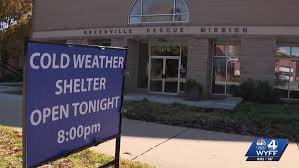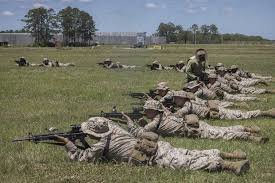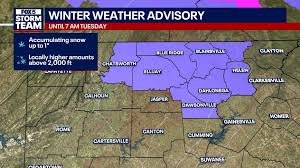
Asheville Weather Update: Life-Saving Cold Weather Shelters Open Across the Carolinas
As the crisp air of autumn gives way to the biting chill of winter, the breathtaking beauty of the Blue Ridge Mountains, particularly around Asheville, brings with it a stark reality for many. When the Asheville weather dips to freezing temperatures, the need for safe, warm spaces becomes a matter of life and death. Across the Carolinas, cold weather shelters are opening their doors, offering not just refuge from the elements, but a beacon of hope.
The dangers of exposure are tragically real. Jessie Figueroa with Homeward Bound in Asheville recounts harrowing experiences: “You’ll hear some of our staff tell horrible stories of several years ago when people make the decision to try and stick it out and sleep outside and have frozen to death in the past.” This stark reminder underscores the critical importance of these shelters.
A Critical Need: When Temperatures Plummet in the Carolinas
For individuals without stable housing, dropping temperatures pose immediate and severe threats. Hypothermia and frostbite can set in rapidly, making overnight outdoor stays perilous. Jeremy Huff from Miracle Hill, an organization with a strong presence in the Upstate of South Carolina, emphasizes, “And on these cold nights, it’s a safety problem.”
Organizations like Miracle Hill spring into action when temperatures hit 40 degrees Fahrenheit or below, ensuring no one is turned away due to the cold. Last season, Miracle Hill even welcomed 140 people on their busiest night, showcasing the immense and often unseen demand for their services.
The Growing Crisis of Homelessness in a Changing Environment
The need for shelter is unfortunately on the rise. Recent Point-in-Time Counts reveal a sobering picture: 1,764 people were living without a home in the Upstate of South Carolina alone, with Greenville County facing the highest population, followed by Anderson County.
Further north, Buncombe County, home to Asheville, has also seen a significant increase in its homeless population. A substantial factor contributing to this crisis was the aftermath of Hurricane Helene, which severely impacted affordable housing. Jessie Figueroa with Homeward Bound in Asheville explains, “And after the storm, with such a reduction of our affordable housing as a result of the storm, you just saw a new population that perhaps had never experienced homelessness before ending up outside.” Buncombe County’s count identified 755 homeless individuals within its borders, highlighting the ripple effect of climate events on housing security.
Hope in the Cold: Shelters Providing Warmth and a Path Forward
While cold weather shelters offer immediate relief, their mission extends beyond just a warm bed. They provide an invaluable opportunity to engage with individuals, offering resources and support that can lead to long-term stability.
“It’s a lot of guys who are in a regular shelter have been in the cold weather shelter before,” notes Jeremy Huff, indicating how these emergency services can be a gateway to sustained support. Dave Phillips from Hope Missions in Anderson adds, “It opens up conversations so that we can have with people to help them get out of whatever their situation might be.”
Upstate South Carolina: Vital Resources for Those in Need
Several organizations are on the front lines, ready to assist. Here are some key locations:
- Cherokee County Rescue Mission (Miracle Hill)
227 Henderson Street, Gaffney, SC
Intake Hours: 7 a.m. to 2 p.m.
Capacity: 47 shelter beds plus 6 transitional housing beds
Serves: Men, women, and mothers with children. - Greenville Rescue Mission (Miracle Hill)
575 W Washington St, Greenville, SC 29601
Intake Hours: 7 a.m. to 2 p.m.
Capacity: 153 dormitory-style beds plus 6 respite care beds
Serves: Men only. - Shepard’s Gate (Miracle Hill)
11 Regency Hill Drive, Greenville, SC
Capacity: 63 beds
Serves: Women and mothers with young children. - Spartanburg Rescue Mission (Miracle Hill)
189 North Forest Street, Spartanburg, SC
Capacity: 94 dormitory-style beds
Serves: Men, women, and mothers with children. - Hope Missions (Anderson)
213 South Towers Street, Anderson, SC
Dave Phillips reported preparing for around 50 people on a recent cold night. This warming center plays a crucial role in Anderson, where other shelters may lack capacity. For more details on Hope Missions’ services, please visit their local resource page.
Buncombe County and Asheville: Local Support for Winter’s Chill
For those in Buncombe County navigating the challenges of cold Asheville weather, Homeward Bound WNC is a pivotal organization connecting individuals to services and advocating for housing solutions. Finding a warm place to stay is paramount when temperatures drop.
For up-to-date information on cold weather shelters and warming centers in Buncombe County, including specific locations and operating hours, please refer to Buncombe County’s official emergency services or local news outlets.
How You Can Help: Supporting Our Community
The efforts of these organizations are powered by community support. If you are able, consider:
- Donating: Financial contributions, warm clothing, blankets, and non-perishable food items are always in high demand.
- Volunteering: Lend your time to help staff shelters, prepare meals, or assist with outreach.
- Spreading Awareness: Share information about available shelters and the ongoing need for support.
As winter settles in, and the Asheville weather patterns bring colder fronts, let’s remember the most vulnerable among us. The collective warmth of our community can make a profound difference, ensuring that everyone has a safe place to weather the storm.




